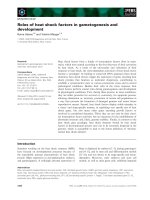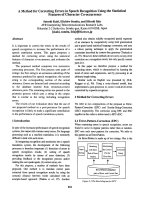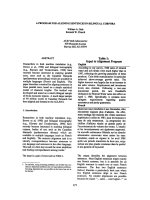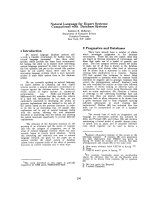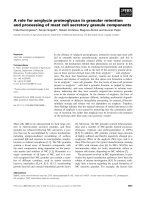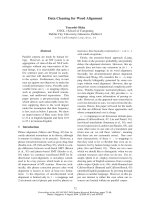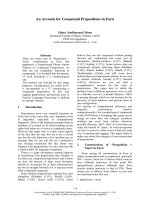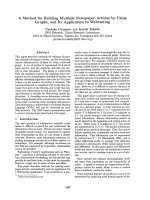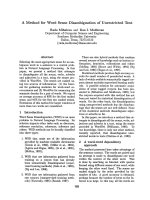Báo cáo khoa học: "Feature-based Method for Document Alignment in Comparable News Corpora" ppt
Bạn đang xem bản rút gọn của tài liệu. Xem và tải ngay bản đầy đủ của tài liệu tại đây (565.99 KB, 9 trang )
Proceedings of the 12th Conference of the European Chapter of the ACL, pages 843–851,
Athens, Greece, 30 March – 3 April 2009.
c
2009 Association for Computational Linguistics
Feature-based Method for Document Alignment in
Comparable News Corpora
Thuy Vu, Ai Ti Aw, Min Zhang
Department of Human Language Technology, Institute for Infocomm Research
1 Fusionopolis Way, #21-01 Connexis, South Tower, Singapore 138632
{tvu, aaiti, mzhang}@i2r.a-star.edu.sg
Abstract
In this paper, we present a feature-based me-
thod to align documents with similar content
across two sets of bilingual comparable cor-
pora from daily news texts. We evaluate the
contribution of each individual feature and
investigate the incorporation of these diverse
statistical and heuristic features for the task of
bilingual document alignment. Experimental
results on the English-Chinese and English-
Malay comparable news corpora show that
our proposed Discrete Fourier Transform-
based term frequency distribution feature is
very effective. It contributes 4.1% and 8% to
performance improvement over Pearson’s
correlation method on the two comparable
corpora. In addition, when more heuristic and
statistical features as well as a bilingual dic-
tionary are utilized, our method shows an ab-
solute performance improvement of 23.2%
and 15.3% on the two sets of bilingual corpo-
ra when comparing with a prior information
retrieval-based method.
1 Introduction
The problem of document alignment is described
as the task of aligning documents, news articles
for instance, across two corpora based on content
similarity. The groups of corpora can be in the
same or in different languages, depending on the
purpose of one’s task. In our study, we attempt to
align similar documents across comparable cor-
pora which are bilingual, each set written in a
different language but having similar content and
domain coverage for different communication
needs.
Previous works on monolingual document
alignment focus on automatic alignment between
documents and their presentation slides or be-
tween documents and their abstracts. Kan (2007)
uses two similarity measures, Cosine and Jac-
card, to calculate the candidate alignment score
in his SlideSeer system, a digital library software
that retrieves documents and their narrated slide
presentations. Daumé and Marcu (2004) use a
phrase-based HMM model to mine the alignment
between documents and their human-written ab-
stracts. The main purpose of this work is to in-
crease the size of the training corpus for a
statistical-based summarization system.
The research on similarity calculation for mul-
tilingual comparable corpora has attracted more
attention than monolingual comparable corpora.
However, the purpose and scenario of these
works are rather varied. Steinberger et al. (2002)
represent document contents using descriptor
terms of a multilingual thesaurus EUROVOC
1
,
and calculate the semantic similarity based on the
distance between the two documents’ representa-
tions. The assignment of descriptors is trained by
log-likelihood test and computed by , Co-
sine, and Okapi. Similarly, Pouliquen et al.
(2004) use a linear combination of three types of
knowledge: cognates, geographical place names
reference, and map documents based on the
EUROVOC. The major limitation of these works
is the use of EUROVOC, which is a specific re-
source workable only for European languages.
Aligning documents across parallel corpora is
another area of interest. Patry and Langlais (2005)
use three similarity scores, Cosine, Normalized
Edit Distance, and Sentence Alignment Score, to
compute the similarity between two parallel doc-
uments. An Adaboost classifier is trained on a list
of scored text pairs labeled as parallel or non-
parallel. Then, the learned classifier is used to
check the correctness of each alignment candidate.
Their method is simple but effective. However,
the features used in this method are only suitable
for parallel corpora as the measurement is mainly
based on structural similarity. One goal of docu-
ment alignment is for parallel sentence extraction
for applications like statistical machine transla-
tion. Cheung and Fung (2004) highlight that most
1
EUROVOC is a multilingual thesaurus covering the fields
in which the European Communities are active.
843
of the current sentence alignment models are ap-
plicable for parallel documents, rather than com-
parable documents. In addition, they argue that
document alignment should be done before paral-
lel sentence extraction.
Tao and Zhai (2005) propose a general method
to extract comparable bilingual text without us-
ing any linguistic resources. The main feature of
this method is the frequency correlation of words
in different languages. They assume that those
words in different languages should have similar
frequency correlation if they are actually transla-
tions of each other. The association between two
documents is then calculated based on this in-
formation using Pearson’s correlation together
with two monolingual features 25, a term
frequency normalization (Stephan et al., 1994),
and . The main advantages of this approach
are that it is purely statistical-based and it is lan-
guage-independent. However, its performance
may be compromised due to the lack of linguistic
knowledge, particularly across corpora which are
linguistically very different. Recently, Munteanu
(2006) introduces a rather simple way to get the
group of similar content document in multilin-
gual comparable corpus by using the Lemur IR
Toolkit (Ogilvie and Callan, 2001). This method
first pushes all the target documents into the da-
tabase of the Lemur, and then uses a word-by-
word translation of each source document as a
query to retrieve similar content target docu-
ments.
This paper will leverage on previous work,
and propose and explore diverse range of fea-
tures in our system. Our document alignment
system consists of three stages: candidate genera-
tion, feature extraction and feature combination.
We verify our method on two set of bilingual
news comparable corpora English-Chinese and
English-Malay. Experimental results show that
1) when only using Fourier Transform-based
term frequency, our method outperforms our re-
implementation of Tao (2005)’s method by 4.1%
and 8% for the top 100 alignment candidates and,
2) when using all features, our method signifi-
cantly outperforms our implementation of Mun-
teanu’s (2006) method by 23.2% and 15.3%.
The paper is organized as follows. In section
2, we describe the overall architecture of our sys-
tem. Section 3 discusses our improved frequency
correlation-based feature, while Section 4 de-
scribes in detail the document relationship heu-
ristics used in our model. Section 5 reports the
experimental results. Finally, we conclude our
work in section 6.
2 System Architecture
Fig 1 shows the general architecture of our doc-
ument alignment system. It consists of three
components: candidate generation, feature ex-
traction, and feature combination. Our system
works on two sets of monolingual corpora to de-
rive a set of document alignments that are com-
parable in their content.
Fig 1. Architecture for Document Alignment Model.
2.1 Candidate Generation
Like many other text processing systems, the
system first defines two filtering criteria to prune
out “clearly bad” candidates. This will dramati-
cally reduce the search space. We implement the
following filers for this purpose:
Date-Window Filter: As mentioned earlier,
the data used for the present work are news cor-
pora—a text genre that has very strong links with
the time element. The published date of docu-
ment is available in data, and can easily be used
as an indicator to evaluate the relation between
two articles in terms of time. Similar to Muntea-
nu’s (2006), we aim to constrain the number of
candidates by assuming that documents with
similar content should have publication dates
which are fairly close to each other, even though
they reside in two different sets of corpora. By
imposing this constraint, both the complexity and
the cost in computation can be reduced tremend-
ously as the number of candidates would be sig-
nificantly reduced. For example, when a 1-day
window size is set, this means that for a given
source document, the search for its target candi-
dates is set within 3 days of the source document:
the same day of publication, the day after, and
the day before. With this filter, using the data of
one-month in our experiment, a reduction of 90%
of all possible alignments can be achieved (sec-
tion 5.1). Moreover, with our evaluation data,
844
after filtering out document pairs using a 1-day
window size, up to 81.6% for English-Chinese
and 80.3% for English-Malay of the golden
alignments are covered. If the window size is
increased to 5, the coverage is 96.6% and 95.6%
for two language pairs respectively.
Title-n-Content Filter: previous date window
filter constrains the number of candidates based
purely on temporal information without exploit-
ing any knowledge of the documents’ contents.
The number of candidates to be generated is thus
dependent on the number of published articles
per day, instead of the candidates’ potential con-
tent similarity. For this reason, we introduce
another filter which makes use of document titles
to gauge content-wise cross document similarity.
As document titles are available in news data, we
capitalize on words found in these document
titles, favoring alignment candidates where at
least one of the title-words in the source docu-
ment has its translation found in the content of
the other target document. This filter can reduce
a further 47.9% (English-Chinese) and 26.3%
(English-Malay) of the remaining alignment can-
didates after applying the date-window filter.
2.2 Feature Extraction
The second step extracts all the features for each
candidate and computes the score for each indi-
vidual feature function. In our model, the feature
set is composed of the Title-n-Content score
(), Linguistic-Independent-Unit score (),
and Monolingual Term Distribution similarity
(). We will discuss all three features in sec-
tions 3 and 4.
2.3 Feature Combination
The final score for each alignment candidate is
computed by combining all the feature function
scores into a unique score. In literature, there are
many methods concerning the estimation of the
overall score for a given feature set, which vary
from supervised to unsupervised method. Super-
vised methods such as Support Vector Machine
(SVM) and Maximum Entropy (ME) estimate
the weight of each feature based on training data
which are then used to calculate the final score.
However, these supervised learning-based me-
thods may not be applicable to our proposed is-
sue as we are motivated to build a language
independent unsupervised system. We simply
take a product of all normalized features to ob-
tain one unique score. This is because our fea-
tures are probabilistically independent. In our
implementation, we normalize the scores to make
them less sensitive to the absolute value by tak-
ing the logarithm
.
as follows:
,
1,
(1)
is a threshold for to contribute posi-
tively to the unique score. In our experiment, we
empirically choose be 2.2, and the threshold
for is 0.51828 (as 2.71828).
3 Monolingual Term Distribution
3.1 Baseline Model
The main feature used in Tao and Zhai (2005) is
the frequency distribution similarity or frequency
correlation of words in two given corpora. It is
assumed that frequency distributions of topically-
related words in multilingual comparable corpora
are often correlated due to the correlated cover-
age of the same events.
Let
,
,…,
and
,
,…,
be the frequency distribution vectors of two
words and in two documents respectively.
The frequency correlation of the two words is
computed by Pearson’s Correlation Coefficient
in (2).
,
∑
∑
∑
∑
∑
∑
∑
(2)
The similarity of two documents is calculated
with the addition of two features namely Inverse
Document Frequency () and 25 term fre-
quency normalization shown in the equation (3).
,
∑
·
·
,
·
,
25
,
· 25
,
(3)
Where 25
,
is the word frequency
normalization for word in document , and
is the average length of a document.
25
,
,
,
|
|
(4)
It is noted that the key feature used by Tao and
Zhai (2005) is the
,
score which depends
purely on statistical information. Therefore, our
motivation is to propose more features to link the
source and target documents more effectively for
a better performance.
3.2 Study on Frequency Correlation
We further investigate the frequency correlation of
words from comparable sets of corpora compris-
ing three different languages using the above-
defined model.
845
Fig 2. Sample of frequency correlation for “Bank Dunia”, “World Bank”, and “世界银行”.
Fig 3. Sample of frequency correlation for “Dunia”, “World”, and “世界”.
Fig 4. Sample of frequency correlation for “Filipina”, “Information Technology”, and “联合国”.
Using three months - May to July, 2006 – of daily
newspaper in Strait Times
2
(in English), Zao Bao
3
(in Chinese), and Berita Harian
4
(in Malay), we
conduct the experiments described in the follow-
ing Fig 2, Fig 3, and Fig 4 showing three different
cases of term or word correlation. In these figures,
the -axis denotes time and the -axis shows the
frequency distribution of the term or word.
Multi-word versus Single-word: Fig 2
illustrates that the distributions for multi-word
term such as “World Bank”, “世界银行(World
Bank in Chinese)”, and “Bank Dunia (World
Bank in Malay)” in the three language corpora
are almost similar because of the discriminative
power of that phrase. The phrase has no variance
and contains no ambiguity. On the other hand,
the distributions for single words may have much
less similarity.
2
an English news agency in
Singapore. Source © Singapore Press Holdings Ltd.
3
a Chinese news agency in Singa-
pore. Source © Singapore Press Holdings Ltd.
4
a Malay news agency in Sin-
gapore. Source © Singapore Press Holdings Ltd.
Related Common Word: we also investigate
the similarity in frequency distribution for related
common single words in the case of “World”,
“世界 (world in Chinese)”, and “Dunia (world in
Malay)” as shown in Fig 3. It can be observed
that the correlation of these common words is not
as strong as that in the multi-word sample illu-
strated in Fig 2. The reason is that there are many
variances of these common words, which usually
do not have high discriminative power due to the
ambiguities presented within them. Nonetheless,
among these variances, there is still a small simi-
lar distribution trends that can be detected, which
may enable us to discover the associations be-
tween them.
Unrelated Common Word: Fig 4 shows the
frequency distribution of three unrelated com-
mon words over the same three-month period.
No correlation in distribution is found among
them.
0
0.05
0.1
0.15
0.2
1 112131415161718191
BankDunia WorldBank
世界银行
0
0.01
0.02
0.03
1 112131415161718191
Dunia World
世界
0
0.05
0.1
0.15
1 112131415161718191
Filipina InformationTechnology
联合国
846
3.3 Enhancement from Baseline Model
3.3.1 Monolingual Term Correlation
Due to the inadequacy of the baseline’s purely
statistical approach, and our studies on the corre-
lations of single, multiple and commonly appear-
ing words, we propose using “term” or “multi-
word” instead of “single-word” or “word” to cal-
culate the similarity of term frequency
distribution between two documents. This
presents us with two main advantages. Firstly,
the smaller number of terms compared to the
number of words present in any document would
imply fewer possible document alignment pairs
for the system. This increases the computation
speed remarkably. To extract automatically the
list of terms in each document, we use the term
extraction model from Vu et al. (2008). In corpo-
ra used in our experiments, the average ratios of
word/term per document are 556/37, 410/28 and
384/28 for English, Chinese, and Malay respec-
tively. The other advantage of using terms is that
terms are more distinctive than words as they
contain less ambiguity, thus enabling high corre-
lation to be observed when compared with single
words.
3.3.2 Bilingual Dictionary Incorporation
In addition to using terms for the computation,
we observed from equation (3) that the only mu-
tual feature relating the two documents is the
frequency distribution coefficient
,
. It is
likely that the alignment performance could be
enhanced if more features relating the two doc-
uments are incorporated.
Following that, we introduce a linguistic fea-
ture,
,
, to the baseline model to
enhance the association between two documents.
This feature involves the comparison of the
translations of words within a particular term in
one language, and the presence of these transla-
tions in the corresponding target language term.
If more translations obtained from a bilingual
dictionary of words within a term are found in
the term extracted from the other language’s
document, it is more likely that the 2 bilingual
terms are translations of each other. This feature
counts the number of word translation found be-
tween the two terms, as described in the follow-
ing. Let
and
be the term list of
and
respectively, the similarity score in our model is:
,
∑
·
·
,
·
,
,
·25
,
·25
,
(5)
3.3.3 Distribution Similarity Measurement
using Monolingual Term
Finally, we apply the results of time-series re-
search to replace Pearson’s correlation which is
used in the baseline model, in our calculation of
the similarity score of two frequency distribu-
tions. A popular technique for time sequence
matching is to use Discrete Fourier Transform
( ) (Agrawal et al, 1993). More recently,
Klementiev and Roth (2006) also use F-index
(Hetland, 2004), a score using , to calculate
the time distribution similarity. In our model, we
assume that the frequency chain of a word is a
sequence, and calculate score for each
chain by the following formula:
.
(6)
In time series research, it is proven that only
the first few coefficients of a chain are
strong and important for comparison (Agrawal et
al, 1993). Our experiments in section 5 show that
the best value for is 7 for both language pairs.
,
(7)
The
,
in equation (5) is replaced by
,
in equation (8) to calculate the Monolin-
gual Term Distribution () score.
4 Document Relationship Heuristics
Besides the , we also propose two heuristic-
based features that focus directly on the
relationship between two multilingual documents,
namely the Title-n-Content score , which
measures the relationship between the title and
content of a document pair, and Linguistic Inde-
pendent Unit score – , which make use of
orthographic similarity between unit of words for
the different languages.
4.1 Title-n-Content Score ()
Besides being a filter for removing bad align-
ment candidates, is also incorporated as a
feature in the computation of document align-
ment score. In the corpora used, in most docu-
ments, “title” does reveal the main topic of a
document. The use of words in a news title is
,
·
,
·
,
·
,
·25
,
·25
,
(8)
847
typically concise and conveys the essence of the
information in the document. Thus, a high
score would indicate a high likelihood of similar-
ity between two bilingual documents. Therefore,
we use as a quantitative feature in our fea-
ture set. Function
,
checks whether the
translation of a word in a document’s title is
found in the content of its aligned document:
,
1, translation of is in
0
,
else
(9)
The score of document
and
is cal-
culated by the following formula:
,
,
T
,
T
(10)
Where
and
are the content of document
and
; and
and
are the set of title words
of two documents.
In addition, this method speeds up the align-
ment process without compromising perfor-
mance when compared with the calculation
based only on contents on both sides.
4.2 Linguistic Independent Unit ()
Linguistic Independent Unit score (LIU) is de-
fined as the piece of information, which is writ-
ten in the same way for different languages. The
following highlight the number 25, 11, and 50 as
linguistic-independent-units for the two sen-
tences.
English: Between Feb 25 and March 11 this
year, she used counterfeit $50 notes 10 times to
pay taxi fares ranging from $2.50 to $4.20.
Chinese:被告使用伪钞的控状,指她从 2 月
25 日至 3 月 11 日,以 50 元面额的伪钞,缴
付介于 2 元 5 角至 4 元 2 角的德士费。
5 Experiment and Evaluation
5.1 Experimental Setup
The experiments were conducted on two sets of
comparable corpora namely English-Chinese and
English-Malay. The data are from three news
publications in Singapore: the Strait Times (ST,
English), Lian He Zao Bao (ZB, Chinese), and
Berita Harian (BH, Malay). Since these languag-
es are from different language families
5
, our
model can be considered as language indepen-
dent.
5
English is in Indo-European; Chinese is in Sino-Tibetan;
Malay is in Austronesian family [Wikipedia].
The evaluation is conducted based on a set of
manually aligned documents prepared by a group
of bilingual students. It is done by carefully read-
ing through each article in the month of June
(2006) for both sets of corpora and trying to find
articles of similar content in the other language
within the given time window. Alignment is
based on similarity of content where the same
story or event is mentioned. Any two bilingual
articles with at least 50% content overlapping are
considered as comparable. This set of reference
data is cross-validated between annotators. Table
1 shows the statistics of our reference data for
document alignment.
Language pair ST – ZB ST – BH
Distinct source 396 176
Distinct target 437 175
Total alignments 438 183
Table 1. Statistics on evaluation data.
Note that although there are 438 alignments
for ST-ZB, the number of unique ST articles are
396, implying that the mapping is not one-to-one.
5.2 Evaluation Metrics
Evaluation is performed on two levels to reflect
performance from two different perspectives.
“Macro evaluation” is conducted to assess the
correctness of the alignment candidates given
their rank among all the alignment candidates.
“Micro evaluation” concerns about the correctness
of the aligned documents returned for a given
source document.
Macro evaluation: we present the perfor-
mance for macro evaluation using average preci-
sion. It is used to evaluate the performance of a
ranked list and gives higher score for the list that
returns more correct alignment in the top.
Micro evaluation: for micro evaluation, we
evaluate the F-Score, calculated from recall and
precision, based on the number of correct align-
ments for the top of alignment candidates for
each source document.
5.3 Experiment and Result
First we implement the method of Tao and Zhai
(2005) as the baseline. Basically, this method
does not depend on any linguistic resources and
calculates the similarity between two documents
purely by comparing all possible pairs of words.
In addition to this, we also implement Muntea-
nu’s (2006) method which uses Okapi scoring
function from the Lemur Toolkit (Ogilvie and
848
Callan, 2001) to obtain the similarity score. This
approach relies heavily on bilingual dictionaries.
To assess performances more fairly, the result
from baseline method of Tao and Zhai are com-
pared against the results of the following list of
incremental approaches: the baseline (A); the
baseline using term instead of word (B); replac-
ing
,
by
,
for feature, with and
without bilingual dictionaries in (C) and (D) re-
spectively; and including and for our
final model in (E). Our model is also compared
our model with results from the implementation
of Munteanu (2006) using Okapi (F), and the
results from a combination of our model with
Okapi (G). Table 2 and Table 3 show the expe-
rimental results for two language pairs English –
Chinese (ST-ZB) and English – Malay (ST-BH),
respectively. Each row displays the result of each
experiment at a certain cut-off among the top
returned alignments. The “Top” columns reflect
the cut-off threshold.
The first three cases (A), (B) and (C), which
do not rely on linguistic resources, suggest that
our new features lead to better performance im-
provement over the baseline. It can be seen that
the use of term and significantly improves
the performance. The improvement indicated by
a sharp increase in all cases from (C) to (D)
shows that dictionaries can indeed help fea-
tures.
Based on the result of (E), our final model
significantly outperforms the model of Munteanu
(F) in both macro and micro evaluation. It is
noted that our features rely less heavily on dic-
tionaries as it only makes use of this resource to
translate term words and title words of a docu-
ment while Munteanu (2006) needs to translate
entire documents, exclude stopword, and relying
on an IR system. It is also observed that the per-
formance of (G) shows that although the incor-
poration of Okapi score in our final model (E)
improves the average precision performance of
ST-ZB slightly, it does not appear to be helpful
for our ST-BH data. However, Okapi does help
in the F-Measure on both corpora.
Pair StraitTimes–ZaoBao
Level Top A B C D E F G
Ave/Precision
Macro
50 0.042 0.083 0.08 0.559 0.430 0.209 0.508
100 0.042 0.069 0.083 0.438 0.426 0.194 0.479
200 0.025 0.069 0.110 0.342 0.396 0.153 0.439
500 0.025 0.054 0.110 0.270 0.351 0.111 0.376
F‐Measure
Micro
1 0.005 0.007 0.009 0.297 0.315 0.157 0.333
2 0.006 0.005 0.013 0.277 0.286 0.133 0.308
5 0.005 0.006 0.009 0.200 0.190 0.096 0.206
10 0.005 0.005 0.007 0.123 0.119 0.063 0.126
20 0.006 0.008 0.007 0.073 0.074 0.038 0.076
Table 2. Performance of Strait Times – Zao Bao.
Pair StraitTimes–BeritaHarian
Level Top A B C D E F G
Ave/Precision
Macro
50 0.000 0.000 0.000 0.514 0.818 0.000 0.782
100 0.000 0.000 0.080 0.484 0.759 0.052 0.729
200 0.000 0.008 0.090 0.443 0.687 0.073 0.673
500 0.005 0.008 0.010 0.383 0.604 0.078 0.591
F‐Measure
Micro
1 0.000 0.000 0.005 0.399 0.634 0.119 0.650
2 0.000 0.004 0.010 0.340 0.515 0.128 0.515
5 0.002 0.005 0.010 0.205 0.270 0.105 0.273
10 0.004 0.014 0.013 0.130 0.150 0.076 0.150
20 0.006 0.017 0.017 0.074 0.078 0.043 0.078
Table 3. Performance of Strait Times – Berita Harian.
849
5.4 Discussion
It can be seen from Table 2 and Table 3 that by
exploiting the frequency distribution of terms
using Discrete Fourier Transform instead of
words on Pearson’s Correlation, performance is
noticeably improved. Fig 5 shows the incremen-
tal improvement of our model for top-200 and
top-2 alignments using macro and micro evalua-
tion respectively. The sharp increase can be seen
in Fig 5 from point (C) onwards.
Fig 5. Step-wise improvement at top-200 for macro
and top-2 for micro evaluation.
Fig 6 compares the performance of our system
with Tao and Zhai (2005) and Munteanu (2006).
It is shown that our systems outperform these
two systems under the same experimental
parameters. Moreover, even without the use of
dictionaries, our system’s performance on ST-
BH data is much better than Munteanu’s (2006)
on the same data.
Fig 6. System comparison for ST-ZB and ST-BH at
top-500 for macro and top-5 for micro evaluation.
We find that dictionary usage contributes
much more to performance improvement in ST-
BH compared to that in ST-ZB. We attribute this
to the fact that the feature LIU already contri-
butes markedly to the increase in the perfor-
mance of ST-BH. As a result, it is harder to make
further improvements even with the application
of bilingual dictionaries.
6 Conclusion and Future Work
In this paper, we propose a feature based model
for aligning documents from multilingual com-
parable corpora. Our feature set is selected based
on the need for a method to be adaptable to new
language-pairs without relying heavily on lin-
guistic resources, unsupervised learning strategy.
Thus, in the proposed method we make use of
simple bilingual dictionaries, which are rather
inexpensive and easily obtained nowadays. We
also explore diverse features, including Mono-
lingual Term Distribution ( ), Title-and-
Content (), and Linguistic Independent Unit
() and measure their contributions in an in-
cremental way. The experiment results show that
our system can retrieve similar documents from
two comparable corpora much better than using
an information retrieval, such as that used by
Munteanu (2006). It also performs better than a
word correlation-based method such as Tao’s
(2005).
Besides document alignment as an end, there
are many tasks that can directly benefit from
comparable corpora with documents that are
well-aligned. These include sentence alignment,
term alignment, and machine translation, espe-
cially statistical machine translation. In the future,
we aim to extract other valuable information
from comparable corpora which benefits from
comparable documents.
Acknowledgements
We would like to thank the anonymous review-
ers for their many constructive suggestions for
improving this paper. Our thanks also go to Ma-
hani Aljunied for her contributions to the linguis-
tic assessment in our work.
References
Percy Cheung and Pascale Fung. 2004. Sentence
Alignment in Parallel, Comparable, and Quasi-
comparable Corpora. In Proceedings of 4th Inter-
national Conference on Language Resources and
Evaluation (LREC). Lisbon, Portugal.
Hal Daume III and Daniel Marcu. 2004. A Phrase-
Based HMM Approach to Document/Abstract
Alignment. In Proceedings of Empirical Methods
in Natural Language Processing (EMNLP). Spain.
0
0.1
0.2
0.3
0.4
0.5
0.6
0.7
0.8
ABCDE
ST‐ ZBA/Prec ST‐ ZBF‐Score
ST‐ BHA/Prec ST‐ BHF‐Score
0
0.1
0.2
0.3
0.4
0.5
0.6
0.7
A/Prec F‐Score A/Prec F‐Score
ST‐ ZB ST‐ BH
TaoandZhai(2005) OurSystemw/oDict
OurSystemwDict Munteanu(2006)
850
Min-Yen Kan. 2007. SlideSeer: A Digital Library of
Aligned Document and Presentation Pairs. In Pro-
ceedings of the Joint Conference on Digital Libra-
ries (JCDL). Vancouver, Canada.
Soto Montalvo, Raquel Martinez, Arantza Casillas,
and Victor Fresno. 2006. Multilingual Document
Clustering: a Heuristic Approach Based on Cog-
nate Named Entities. In Proceedings of the 21st In-
ternational Conference on Computational
Linguistics and the 44th Annual Meeting of the
ACL.
Stephen E. Robertson, Steve Walker, Susan Jones,
Micheline Hancock-Beaulieu, and Mike Gatford.
1994. Okapi at TREC-3. In Proceedings of the
Third Text REtrieval Conference (TREC 1994).
Gaithersburg, USA.
Dragos Stefan Munteanu. 2006. Exploiting Compara-
ble Corpora. PhD Thesis. Information Sciences In-
stitute, University of Southern California. USA.
Ogilvie, P., and Callan, J. 2001. Experiments using
the Lemur toolkit. In Proceedings of the 10
th
Text
REtrieval Conference (TREC).
Alexandre Patry and Philippe Langlais. 2005. Auto-
matic Identification of Parallel Documents with
light or without Linguistics Resources. In Proceed-
ings of 18th Annual Conference on Artificial Intel-
ligent.
Bruno Pouliquen, Ralf Steinberger, Camelia Ignat,
Emilia Kasper, and Irina Temnikova. 2004. Multi-
lingual and Cross-lingual news topic tracking. In
Proceedings of the 20th International Conference
on Computational Linguistics (COLING).
Ralf Steinberger, Bruno Pouliquen, and Johan Hag-
man. 2002. Cross-lingual Document Similarity
Calculation Using the Multilingual Thesaurus
EUROVOC. Computational Linguistics and Intel-
ligent Text Processing.
Tao Tao and ChengXiang Zhai. 2005. Mining Com-
parable Bilingual Text Corpora for Cross-
Language Information Integration. In Proceedings
of the 2005 ACM SIGKDD International Confe-
rence on Knowledge Discovery and Data Mining.
Thuy Vu, Ai Ti Aw and Min Zhang. 2008. Term ex-
traction through unithood and termhood unification.
In Proceedings of the 3rd International Joint Con-
ference on Natural Language Processing
(IJCNLP-08). Hyderabad, India.
ChengXiang Zhai and John Lafferty. 2001. A study of
smoothing methods for language models applied to
Ad Hoc information retrieval. In Proceedings of
the 24th annual international ACM SIGIR confe-
rence on Research and development in information
retrieval. Louisiana, United States.
R. Agrawal, C. Faloutsos, and A. Swami. 1993. Effi-
cient similarity search in sequence databases. In
Proceedings of the 4
th
International Conference on
Foundations of Data Organization and Algorithms.
Chicago, United States.
Magnus Lie Hetland. 2004. A survey of recent me-
thods for efficient retrieval of similar time se-
quences. In Data Mining in Time Series Databases.
World Scientific.
Alexandre Klementiev and Dan Roth. 2006. Weakly
Supervised Named Entity Transliteration and Dis-
covery from Multilingual Comparable Corpora. In
Proceedings of the 21st International Conference
on Computational Linguistics and the 44th Annual
Meeting of the ACL.
851
